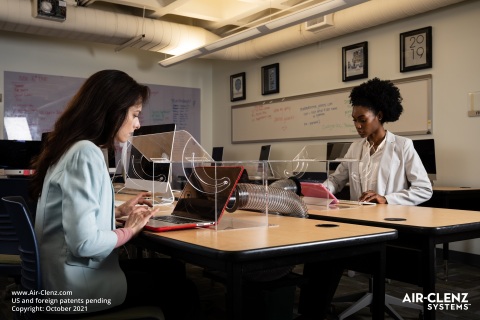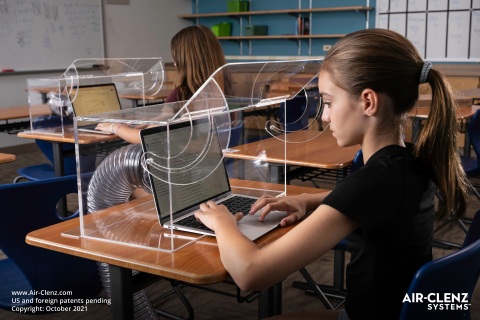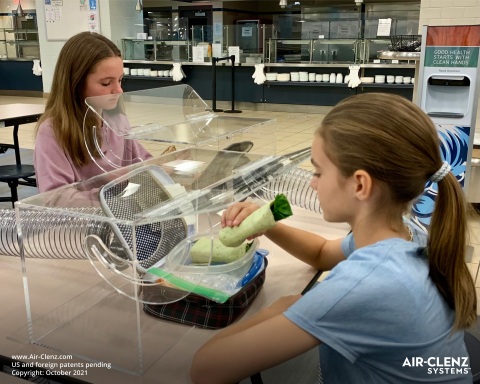Leading Healthcare, HVAC Experts Call for More Focus on New Ventilation Approaches That Capture and Clean Exhaled Breaths Quicker
Air-Clenz Only Known Technology That Addresses Quick Capture and Clean
ATLANTA – (BUSINESS WIRE) – A group of healthcare professionals and ventilation experts today called for various groups, including the Center for Disease Control, the U.S. Department of Education, and the leading ventilation standards-making organization (ASHRAE), to focus on new approaches to improving indoor air quality for decreasing the risk of COVID and influenza outbreaks in schools, offices, and other indoor environments.
Existing methods, including upgrades to existing ventilation systems, have proven somewhat ineffective as COVID outbreaks continue to create disruptions in school systems throughout the United States.
“We know that COVID, as well as many other viruses, are airborne, meaning they spread through the air in microscopic, aerosolized particles”
The U.S. Dept. of Education announced this summer that $120 billion is available through the American Rescue Plan for K-12 schools to spend on improvements in various areas, one of which is ventilation to reduce the risk of airborne pathogen transmission. Despite these efforts, COVID outbreaks have been reported in school systems from California to Michigan to New Jersey, creating school disruptions and in some cases forcing students into remote learning environments once again. The August 2020 Harvard 5 Step Guide for Checking Ventilation Rates in Classrooms recommends five or more room air turns per hour for schools, however, as stated in the JAMA April 16, 2021, paper Indoor Air Changes and Potential Implications for SARS-CoV-2 Transmission, many schools in the U.S. average far less than three air turns per hour.
“For sure, some school HVAC systems are below standard, but even those that are working correctly do not remove pathogens from exhaled air prior to becoming dispersed within the room’s air flow in order to prevent COVID outbreaks,” said Larry Schoen, P.E., Fellow ASHRAE, Principal Engineer for Schoen Engineering Inc. “Existing ventilation systems in schools, offices and elsewhere were not built for virus control. Not only does better ventilation decrease the risk of catching COVID, it has been shown to also improve work productivity and/or school performance. And even after upgrading a traditional HVAC ventilation system with better filters it still allows virus-laden air to affect others in a room, creating the potential for contagion.”
Instead, according to Schoen, Dr. Rama Rao Amara, Emory University School of Medicine, and Dr. Kevin Karem, a former CDC director who now works with the FDA, new ventilation approaches are needed. One extremely effective approach is to capture exhaled air closer to a person’s face. Amara, Karem and Schoen are members of the Air-Clenz scientific advisory board.
“We know that COVID, as well as many other viruses, are airborne, meaning they spread through the air in microscopic, aerosolized particles,” said Dr. Amara. “So, it makes sense that these particles can be easily pulled by the room’s HVAC system and/or larger air purifier. To stop COVID and other pathogens, such as influenza or even the common cold from spreading in indoor environments, it is vital to capture an exhaled breath before these aerosols have a chance to journey around a room. We need to re-evaluate how indoor air quality is managed.”
ASHRAE guidelines — which are recommended by the CDC and other government agencies — center around ensuring good air flow, and improved filters. These are important steps, according to Schoen and others, but they only address the removal of virus-laden particles after they’ve travelled perhaps 10-25 feet or more across a room.
To date, there is only one technology that addresses the need for a “quick capture and clean” approach. Air-Clenz Systems™, LLC (Air-Clenz) recently announced the only known system in the world that can capture and clean an estimated 85 percent of individuals’ exhaled breaths within the range of 2 inches to three feet of their face, and within approximately three seconds, lowering the risk of COVID-19 transmission in indoor environments in school classrooms and cafeterias, and offices. The company recently provided video proof, illustrating its system’s ability.
The patent pending Air-Clenz unit consists of two main parts: an exhaled air collector, which effectively corrals a person’s exhaled air, and a small, exhaled air purification chamber — which includes medical-grade HEPA filters — that is attached to the air collector.
This innovative breakthrough is designed for classrooms so that teachers can always see students as they did in pre-COVID settings. The size and positioning of the unit on the desk or cafeteria tabletop permit the student or worker to place their computer, textbook, or lunch tray within the air collection unit, so that a student’s or worker’s exhaled air is being captured and cleaned of viruses or other pathogens while they study, eat or work. In addition, by having multiple Air-Clenz systems present within a room (one on each of the student’s or worker’s desks), air circulation in the room is increased significantly, resulting in substantially more room air turns of cleaned air per hour.
Air-Clenz’s technology is additive to that of any venue’s HVAC system, providing for even cleaner indoor air, more cleaned room air turns per hour and potentially speeding up the removal of masks.
“Capturing exhaled air close to the face before it becomes dispersed has been totally overlooked,” said Stuart Sheldon, CEO of Air-Clenz Systems. “Except for a face mask, which most individuals would not want to wear for the rest of their lives, there is no known system in the world that captures even 50 percent of one’s exhaled air without also cleaning 100 percent of the air in a room or enclosed space. There are literally hundreds of different commercial air purifiers and HVAC system options, but none come close to achieving what Air-Clenz can achieve.”
The call by Schoen, Amara, Karem and others is not totally new. Improving indoor air quality via improved ventilation is now recognized as one of the keys to stopping the spread of COVID-19 and other airborne pathogens, especially among those too young to be vaccinated, according to a May 2021 Johns Hopkins Center for Health Security report, School Ventilation: A Vital Tool to Reduce COVID-19 Spread. Science Galley also recently reported that improved indoor ventilation is key to combat indoor respiratory infection.
Dr. Anita Broach, Air-Clenz’s Chief Scientist, states: “Research demonstrates that Air-Clenz’ technology typically captures and cleans more than an estimated 85 percent of a seated person’s exhaled breath in approximately three seconds. The captured air is then cleaned to a 99.9 percent level within an air purification chamber before being recirculated back into the venue. And by utilizing one Air-Clenz unit for each seated person in a room the number of room air turns per hour can be increased substantially. By way of example, an average size classroom in the U.S. having 20 or more students each using Air-Clenz can increase the room’s cleaned air turns per hour to 6 or more, which meets or exceeds the Harvard recommended number of room air turns per hour for a classroom.”
About Air-Clenz Systems and its Scientific Advisory Board
Air-Clenz Systems (www.air-clenz.com), based in Atlanta, Ga., was launched by success-proven inventors, scientists, and collaboration partners attempting to solve major global challenges caused by the coronavirus pandemic, with an eye to benefiting the global population at large. The management team at Air-Clenz has a substantial track record of identifying global needs, inventing solutions to satisfy such needs, protecting intellectual property, developing technology, and selling or licensing the inventions to Fortune 500 companies.
Air-Clenz Systems developed its proprietary technology for the collection, isolation, and removal of pathogens (such as viruses) from exhaled air before they have a chance to disperse and be transmitted to others. The technology can be adapted to fit most any environment where individuals are seated, including schools, offices, houses of worship, offices, learning institutions, theaters, and vehicles. In addition, Air-Clenz has adapted its technology to work in elevators.
Air-Clenz’ Scientific Advisory Board includes Rama Rao Amara, PhD and professor, Emory Vaccine Center, Professor Department of Microbiology and Immunology, Emory University School of Medicine; Kevin Karem, PhD, Director of one of FDAs laboratories and former Global Health Associate Director for Laboratory Science at the CDC; Victoria Cerami, Chief Executive Officer, Cerami & Associates an acoustic engineering firm of 80+ engineers; Chengzhi Shi, PhD, Assistant professor of Mechanical Engineering at Georgia Tech specializing in acoustics; Lawrence J. Schoen, P.E., Fellow ASHRAE, Principal Engineer for Schoen Engineering Inc.; Ernest Conrad, P.E., BOMA Fellow, principal in charge of Conrad Engineers, a professional engineering consulting firm; and Anita T. Broach, PhD, Material Scientist, Chemical Engineer and Air-Clenz Chief Scientist.




